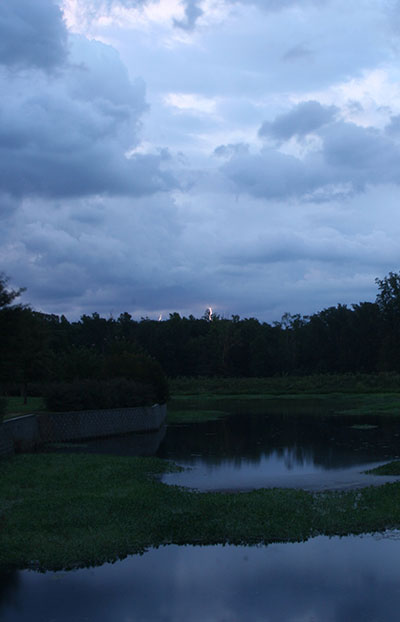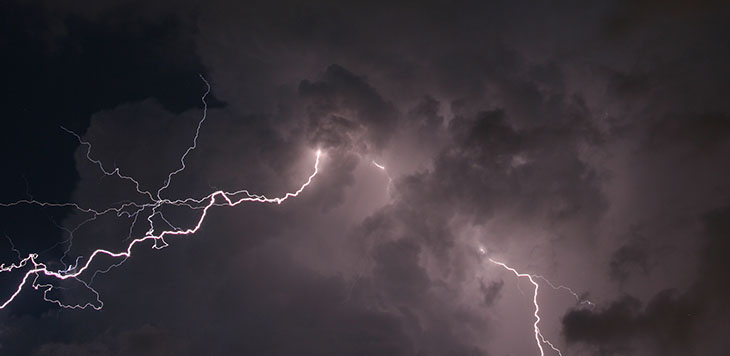So, I’ve always had this thing about capturing images of lightning, perhaps even before I had a decent camera to do so. But it’s an exceptionally tricky thing; storms may not provide great displays, and when they do, it is often not at a viewing angle that works with the surroundings – blocked by trees or buildings, or over something not too photogenic. For the past few years, I’ve been nowhere near a nice, open area where approaching or receding storms can be seen clearly, and the few times I’ve tried to get someplace, I found the storm moved off or never even came close in the first place.
With the recent move, there’s this pond not two kilometers away, with nice open viewing areas on both ends and several narrower choices surrounding. I noticed that evening thunderstorms looked pretty likely this week, so I started plotting.
This evening, I looked out the front door and saw one of those dramatic scenes: a towering thunderhead lit by the lowering sun, flanked by lower clouds already in shadow, a nice juxtaposition of brilliant yellow cottony folds and blue-grey framing. It was in a position that might have been ideally situated over the pond, so I grabbed the gear and scampered over.
Unfortunately, the lower clouds shifted and obscured the sunlit cumulonimbus, not at all surprising – this is how shooting weather patterns tends to be. I waited it out, hoping for a break in the clouds or something else interesting to happen, and noticed that another, more distant cloud was producing some internal flashes. This was right at sunset, and the darkening skies would allow for some long exposure times, the best method of capturing lightning strikes. In short, pick an area of activity and lock the shutter open for several seconds, or even shoot on Bulb, where the shutter stays open as long as you want it to. With luck, you’ll capture a distinct lightning strike someplace in the frame. With a lot more luck, you’ll get something well-composed, well-lit, and able to be cropped into a great composition.
 I stress this a lot: lightning isn’t cooperative and may strike in a broad area. Go with a wide angle lens, and while you might capture the bolt, it may have been reduced so small in the frame that it appears feeble and not terribly imposing. Too narrow, or course, and the strike occurs just outside of your frame. And then there’s the timing. Just like the breezes kick up the moment you go in close to some fragile plant, making it impossible to focus, lightning is notorious for striking dramatically while your shutter is closed in between frames (the same can be said for meteors, by the way.) There is, however, one small trait that can increase your odds just a little. For some reason, lightning is somewhat periodic; start counting the moment you see a bolt, and note when the next one occurs in the same general area. Use this as a pattern, and open your shutter a little before the next one is ‘due.’ It’s far from perfect, but I’ve seen it so often that I’m convinced it’s true. Note that another strike may occur from a different portion of the thunderhead in the meantime, which is why I stress that ‘same area’ thing above – the flashes can alternate.
I stress this a lot: lightning isn’t cooperative and may strike in a broad area. Go with a wide angle lens, and while you might capture the bolt, it may have been reduced so small in the frame that it appears feeble and not terribly imposing. Too narrow, or course, and the strike occurs just outside of your frame. And then there’s the timing. Just like the breezes kick up the moment you go in close to some fragile plant, making it impossible to focus, lightning is notorious for striking dramatically while your shutter is closed in between frames (the same can be said for meteors, by the way.) There is, however, one small trait that can increase your odds just a little. For some reason, lightning is somewhat periodic; start counting the moment you see a bolt, and note when the next one occurs in the same general area. Use this as a pattern, and open your shutter a little before the next one is ‘due.’ It’s far from perfect, but I’ve seen it so often that I’m convinced it’s true. Note that another strike may occur from a different portion of the thunderhead in the meantime, which is why I stress that ‘same area’ thing above – the flashes can alternate.
So this evening, I’m watching the activity, and seeing mostly intercloud flashes without visible bolts. Sometimes this can work really well in full darkness, because it illuminates and shapes the cloud, but while there’s still light in the sky shining on the clouds, this will often obscure any internal lighting. I captured a few tiny bolts, but nothing interesting – mostly what I have are enough shots to demonstrate the cloud movements.
Then I noticed that the quiet cloud almost directly overhead was starting to get active. This was a much better view, but there’s a problem with this, one that anyone trying out lightning photography needs to know: lightning is unpredictable (the observation above notwithstanding,) and can strike well outside of what we might think is an ‘active’ region. Here I was, standing in an open field on the edge of a retaining wall well above the level of the pond, with no tall trees nearby, and right alongside an aluminum tripod. Looking up at an active cloud nearly overhead. This is not ideal.
Here’s a little trait of lightning, by the way. People tend to think that, if the bolt misses you, you’re fine – nuh uh. The bolt is the most visible, strongest portion of a whole region of air that is highly charged – it has to be, because that’s how lightning even occurs, leapfrogging from charged area to charged area. Anything that conducts electricity can serve as a conduit for this charge, so while a bolt might strike a tree nearby and ‘totally miss’ you, something metallic can still gather enough electricity to be dangerous – it is estimated that most of the non-lethal lightning injuries to humans occur this way.

The cloud above was putting on a nice show, and the pattern thing was holding very well – I was getting a strike about every twenty seconds, but all of it cloud activity, stretching across the sky while barely even producing any thunder. There was nothing to place in the foreground, nothing even remotely tall enough. I could have crouched under a tree and framed against some branches, but I’m not that stupid.

By now, the sky was almost completely dark, and even the strikes within the clouds were illuminating them nicely, providing a brilliant three-dimensional effect. But there were plenty of bolts outside as well, often stretching across clear sky – this wasn’t a storm front, but isolated thunderheads or ‘cells’ produced by high humidity and sweltering daytime temperatures, the kind of thing that makes Florida ideal for storm photography.
And then,

CRACK!
From the very brief delay between the light show and the explosion of thunder, I’m sure the strike was close – within a few hundred meters. This was the first, and only, ground strike that I’d seen, and it was way too goddamn close for comfort. It occurred right at the tail end of a ten-second exposure, and a quick glance at the LCD told me I’d captured it more than adequately. “That’s it,” I said out loud, shut the camera off, and grabbed the tripod to head for the car, not even removing the camera first. This in itself is an indication of how jumpy I was, since I consider this a serious no-no – it’s just asking for damage to the camera. Always remove the camera first before picking up the tripod to walk anyplace, and stow it safely in your bag. Unless you’re considering just how lucky you are to be alive, much less capture such a dramatic shot.
This, by the way, is the entire frame, unlike the tighter crops above, and I was shooting at 19mm focal length, so it’s a wide angle of view. Maybe I’m imagining it, but it seems to me you can even see the angle of the main bolt – at the very least you gotta appreciate the lens flare along it, making it almost sparkle. I’m very pleased with it, but I realize I was taking a chance I knew not to take, and the storm demonstrated how unpredictable they can be – things could have been much different. So let me repeat the warnings: stay safe!
* * * * *
I have several observations to make, outside of the main narrative. First off, you realize that, on the same day that I posted (again) a rather defiant view of religion, I was standing in an open field next to a heavy aluminum tripod in a thunderstorm (well, okay, not far from one,) and still emerged unscathed. Answer that one, religious folk!
Moving on.
I have this peculiar thing that occurs with my hands – maybe it happens to a lot of people, but I’ve never gotten the impression that it’s common – but if I close my hand in a pinching position and put leverage on the wrist in the wrong way, I can pinch a nerve; this feels exactly like an electric shock, a serious one that can go up the forearm, and it’s produced more than a few cusses over the years. I just have to note that, as I walked quickly back to the car tonight breaking down the tripod as I went, I did it again. I can only consider this less than optimal timing, because I was already jumpy and this didn’t help.
Switching topics again, I still feel a little dissatisfied with the ‘CRACK‘ above (no, not the dig at religious folk – I’m more than happy with those.) There just isn’t any good way of communicating the sudden, very sharp, abusively loud noise of a nearby lightning strike in writing, and even if I were relating this orally, I couldn’t produce any sound that would do it justice – I’d probably sound a bit goofy even trying. This isn’t right; we’re a storytelling species, we should be able to produce some kind of sound, without breaking a cedar plank, that can convey the drama. Intelligent design my ass…




















































